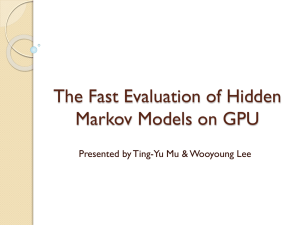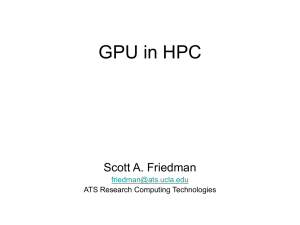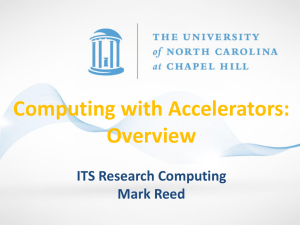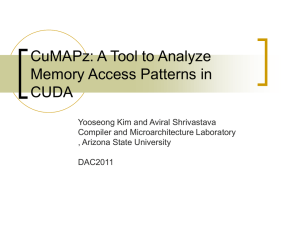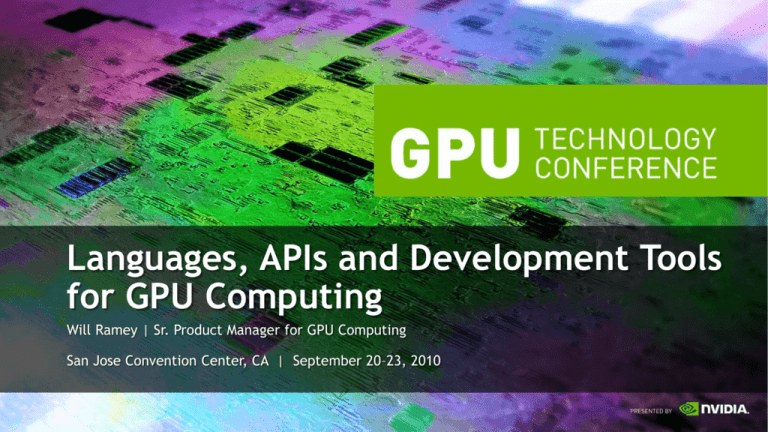
Languages, APIs and Development Tools
for GPU Computing
Will Ramey | Sr. Product Manager for GPU Computing
San Jose Convention Center, CA | September 20–23, 2010
“GPU Computing”
Using all processors in the system for the things they are
best at doing
— Evolution of CPUs makes them good at sequential, serial tasks
— Evolution of GPUs makes them good at parallel processing
Mathematical
Packages
Libraries
Consultants, Training
& Certification
Research & Education
DirectX
Integrated
Development Environment
Parallel Nsight for MS Visual Studio
Tools & Partners
GPU Computing Ecosystem
Languages & API’s
Fortran
NVIDIA Confidential
All Major Platforms
CUDA - NVIDIA’s Architecture for GPU Computing
Broad Adoption
Over 250M installed
CUDA-enabled GPUs
GPU Computing Applications
Over 650k CUDA Toolkit
downloads in last 2 Yrs
Windows, Linux and
MacOS Platforms
supported
GPU Computing spans
HPC to Consumer
350+ Universities
teaching GPU Computing
on the CUDA Architecture
CUDA
C/C++
OpenCL
Over 100k developers
Running in Production
since 2008
SDK + Libs + Visual
Profiler and Debugger
Commercial OpenCL
Conformant Driver
Public Availability
across all CUDA
Architecture GPU’s
SDK + Visual Profiler
Direct
Compute
Microsoft API for
GPU Computing
Supports all CUDAArchitecture GPUs
(DX10 and DX11)
Fortran
PGI Accelerator
PGI CUDA Fortran
NVIDIA GPU
with the CUDA Parallel Computing Architecture
OpenCL is a trademark of Apple Inc. used under license to the Khronos Group Inc.
Python,
Java, .NET, …
PyCUDA
GPU.NET
jCUDA
GPU Computing Software Stack
Your GPU Computing Application
Application Acceleration Engines (AXEs)
Middleware, Modules & Plug-ins
Foundation Libraries
Low-level Functional Libraries
Development Environment
Languages, Device APIs, Compilers, Debuggers, Profilers, etc.
CUDA Architecture
Languages & APIs
© NVIDIA Corporation 2010
Many Different Approaches
Application level integration
High level, implicit parallel languages
Abstraction layers & API wrappers
High level, explicit language integration
Low level device APIs
GPUs for MathWorks Parallel Computing Toolbox™
and Distributed Computing Server™
Workstation
MATLAB Parallel Computing Toolbox (PCT)
Compute Cluster
MATLAB Distributed Computing Server (MDCS)
• PCT enables high performance through
parallel computing on workstations
• MDCS allows a MATLAB PCT application to be
submitted and run on a compute cluster
• NVIDIA GPU acceleration now available
• NVIDIA GPU acceleration now available
NVIDIA Confidential
MATLAB Performance with Tesla
Relative Performance, Black-Scholes Demo
Compared to Single Core CPU Baseline
Single Core CPU
Quad Core CPU
Single Core CPU + Tesla C1060
Quad Core CPU + Tesla C1060
12.0
Relative Execution Speed
10.0
8.0
6.0
4.0
2.0
256 K
1,024 K
4,096 K
16,384 K
Input Size
Core 2 Quad Q6600 2.4 GHz, 6 GB RAM, Windows 7 64-bit, Tesla C1060, single precision operations
NVIDIA Confidential
SUBROUTINE SAXPY (A,X,Y,N)
INTEGER N
REAL A,X(N),Y(N)
!$ACC REGION
DO I = 1, N
X(I) = A*X(I) + Y(I)
ENDDO
!$ACC END REGION
END
PGI Accelerator
Compilers
compile
Auto-generated GPU code
Host x64 asm File
saxpy_:
…
movl
movl
call
. . .
call
…
call
…
call
…
call
link
…
call
…
Unified
a.out
execute
(%rbx), %eax
%eax, -4(%rbp)
__pgi_cu_init
__pgi_cu_function
__pgi_cu_alloc
__pgi_cu_upload
__pgi_cu_call
__pgi_cu_download
+
typedef struct dim3{ unsigned int x,y,z; }dim3;
typedef struct uint3{ unsigned int x,y,z; }uint3;
extern uint3 const threadIdx, blockIdx;
extern dim3 const blockDim, gridDim;
static __attribute__((__global__)) void
pgicuda(
__attribute__((__shared__)) int tc,
__attribute__((__shared__)) int i1,
__attribute__((__shared__)) int i2,
__attribute__((__shared__)) int _n,
__attribute__((__shared__)) float* _c,
__attribute__((__shared__)) float* _b,
__attribute__((__shared__)) float* _a )
{ int i; int p1; int _i;
i = blockIdx.x * 64 + threadIdx.x;
if( i < tc ){
_a[i+i2-1] = ((_c[i+i2-1]+_c[i+i2-1])+_b[i+i2-1]);
_b[i+i2-1] = _c[i+i2];
_i = (_i+1);
p1 = (p1-1);
} }
… no change to existing makefiles, scripts, IDEs,
programming environment, etc.
PyCUDA / PyOpenCL
Slide courtesy of Andreas Klöckner, Brown University
http://mathema.tician.de/software/pycuda
CUDA C: C with a few keywords
void saxpy_serial(int n, float a, float *x, float *y)
{
for (int i = 0; i < n; ++i)
y[i] = a*x[i] + y[i];
}
// Invoke serial SAXPY kernel
saxpy_serial(n, 2.0, x, y);
Standard C Code
__global__ void saxpy_parallel(int n, float a, float *x, float *y)
{
int i = blockIdx.x*blockDim.x + threadIdx.x;
if (i < n) y[i] = a*x[i] + y[i];
CUDA C
}
// Invoke parallel SAXPY kernel with 256 threads/block
int nblocks = (n + 255) / 256;
saxpy_parallel<<<nblocks, 256>>>(n, 2.0, x, y);
Code
Write GPU kernels in C#, F#, VB.NET, etc.
Exposes a minimal API accessible from any
.NET-based language
— Learn a new API instead of a new language
JIT compilation = dynamic language support
Don’t rewrite your existing code
— Just give it a ―touch-up‖
OpenCL
Cross-vendor open standard
— Managed by the Khronos Group
Low-level API for device management and
launching kernels
http://www.khronos.org/opencl
— Close-to-the-metal programming interface
— JIT compilation of kernel programs
C-based language for compute kernels
— Kernels must be optimized for each processor architecture
NVIDIA released the first OpenCL conformant driver for
Windows and Linux to thousands of developers in June 2009
DirectCompute
Microsoft standard for all GPU vendors
— Released with DirectX® 11 / Windows 7
— Runs on all 100M+ CUDA-enabled DirectX 10 class GPUs and later
Low-level API for device management and launching kernels
— Good integration with DirectX 10 and 11
Defines HLSL-based language for compute shaders
— Kernels must be optimized for each processor architecture
Language & APIs for GPU Computing
Approach
Examples
Application Integration
MATLAB, Mathematica, LabVIEW
Implicit Parallel Languages PGI Accelerator, HMPP
Abstraction Layer/Wrapper
PyCUDA, CUDA.NET, jCUDA
Language Integration
CUDA C/C++, PGI CUDA Fortran
Low-level Device API
CUDA C/C++, DirectCompute, OpenCL
Development Tools
© NVIDIA Corporation 2010
Parallel Nsight for Visual Studio
Integrated development for CPU and GPU
Build
Debug
Profile
Windows GPU Development for 2010
NVIDIA Parallel Nsight ™ 1.5
nvcc
FX Composer
cuda-gdb
Shader Debugger
cuda-memcheck
PerfHUD
Visual Profiler
ShaderPerf
cudaprof
Platform Analyzer
4 Flexible GPU Development Configurations
Desktop
Single machine, Single NVIDIA GPU
Analyzer, Graphics Inspector
Single machine, Dual NVIDIA GPUs
Analyzer, Graphics Inspector, Compute Debugger
Networked
Two machines connected over the network
Analyzer, Graphics Inspector, Compute Debugger, Graphics Debugger
TCP/IP
Workstation SLI
SLI Multi OS workstation with two Quadro GPUs
Analyzer, Graphics Inspector, Compute Debugger, Graphics Debugger
© NVIDIA Corporation 2010
NVIDIA cuda-gdb
CUDA debugging integrated
into GDB on Linux
Supported on 32bit and 64bit
systems
Seamlessly debug both the
host/CPU and device/GPU code
Set breakpoints on any source
line or symbol name
Access and print all CUDA
memory allocs, local, global,
constant and shared vars
Included in the CUDA Toolkit
Parallel Source
Debugging
Allinea DDT debugger
Latest News from Allinea
CUDA SDK 3.0 with DDT 2.6
Released June 2010
Fermi and Tesla support
cuda-memcheck support for memory errors
Combined MPI and CUDA support
Stop on kernel launch feature
Kernel thread control, evaluation and
breakpoints
Identify thread counts, ranges and CPU/GPU
threads easily
SDK 3.1 in beta with DDT 2.6.1
SDK 3.2
Coming soon: multiple GPU device support
TotalView Debugger
Latest from TotalView debugger (in Beta)
—
Debugging of application running on the GPU device
—
Full visibility of both Linux threads and GPU device threads
—
—
—
Device threads shown as part of the parent Unix process
Correctly handle all the differences between the CPU and GPU
Fully represent the hierarchical memory
Display data at any level (registers, local, block, global or host memory)
Making it clear where data resides with type qualification
Thread and Block Coordinates
Built in runtime variables display threads in a warp, block and thread
dimensions and indexes
Displayed on the interface in the status bar, thread tab and stack frame
Device thread control
—
Handles CUDA function inlining
—
Step in to or over inlined functions
Reports memory access errors
—
Warps advance Synchronously
CUDA memcheck
Can be used with MPI
NVIDIA Visual Profiler
Analyze GPU HW performance
signals, kernel occupancy,
instruction throughput, and more
Highly configurable
tables and graphical views
Save/load profiler sessions or
export to CSV for later analysis
Compare results visually
across multiple sessions to
see improvements
Windows, Linux and Mac OS X
OpenCL support on Windows and Linux
Included in the CUDA Toolkit
GPU Computing SDK
Hundreds of code samples for
CUDA C, DirectCompute and OpenCL
Finance
Oil & Gas
Video/Image Processing
3D Volume Rendering
Particle Simulations
Fluid Simulations
Math Functions
Application
Design Patterns
© 2009 NVIDIA Corporation
Trivial Application
Design Rules:
Serial task processing on CPU
Data Parallel processing on GPU
Copy input data to GPU
Perform parallel processing
Copy results back
Follow guidance in the
CUDA C Best Practices Guide
Application
CPU C Runtime
CPU
The CUDA C Runtime could be substituted
with other methods of accessing the GPU
CPU
Memory
CUDA
CUDA
OpenCL
CUDA
CUDA.NET
PyCUDA
C
Driver
Fortran
Runtime
Driver
API
GPU
GPU
Memory
Basic Application
“Trivial Application” plus:
Maximize overlap of data transfers and computation
Minimize communication required between processors
Use one CPU thread to manage each GPU
Application
CPU C Runtime
CPU
Multi-GPU notebook, desktop,
workstation and cluster node
configurations are increasingly common
CPU
Memory
CUDA C Runtime
GPU
GPU
Memory
GPU
GPU
Memory
Graphics Application
“Basic Application” plus:
Use graphics interop to avoid unnecessary copies
In Multi-GPU systems, put buffers to be displayed in GPU
Memory of GPU attached to the display
Application
CPU C Runtime
CPU
CPU
Memory
CUDA C Runtime
GPU
OpenGL / Direct3D
GPU
Memory
Basic Library
“Basic Application” plus:
Avoid unnecessary memory transfers
Use data already in GPU memory
Create and leave data in GPU memory
Library
CPU C Runtime
CPU
These rules apply to plug-ins as well
CPU
Memory
CUDA C Runtime
GPU
GPU
Memory
Application with Plug-ins
“Basic Application” plus:
Plug-in Mgr
Allows Application and Plug-ins
to (re)use same GPU memory
Multi-GPU aware
Follow “Basic Library” rules
for the Plug-ins
Application
Plug-in Mgr
Plug-in
CPU C Runtime
CPU
CPU
Memory
Plug-in
Plug-in
CUDA C Runtime
GPU
GPU
Memory
Database Application
Minimize network communication
Move analysis “upstream”
to stored procedures
Client Application
or
Application Server
Treat each stored procedure
like a “Basic Application”
App Server could also be a
“Basic Application”
Client Application is also a
“Basic Application”
Database Engine
CPU C Runtime
CPU
Data Mining, Business Intelligence, etc.
CPU
Memory
Stored Procedure
CUDA C Runtime
GPU
GPU
Memory
Multi-GPU Cluster Application
Application
“Basic Application” plus:
CPU C Runtime
Use Shared Memory for
intra-node communication
or pthreads, OpenMP, etc.
Use MPI to communicate
between nodes
MPI over Ethernet, Infiniband, etc.
CPU
CPU
Memory
CUDA C Runtime
GPU
GPU
Memory
GPU
GPU
Memory
Application
CPU C Runtime
CPU
CPU
Memory
CUDA C Runtime
GPU
GPU
Memory
GPU
GPU
Memory
Application
CPU C Runtime
CPU
CPU
Memory
CUDA C Runtime
GPU
GPU
Memory
GPU
GPU
Memory
Libraries
© 2009 NVIDIA Corporation
CUFFT 3.2: Improved Radix-3, -5, -7
Radix-3 (SP, ECC off)
Radix-3 (DP, ECC off )
70
250
60
200
150
C2070 R3.2
C2070 R3.1
100
GFLOPS
GFLOPS
50
40
C2070 R3.2
C2070 R3.1
30
MKL
MKL
20
50
10
0
0
1
2
3
4
5
6
7
8
9
10 11 12 13 14 15
log3(size)
Radix-5, -7 and mixed radix improvements not shown
CUFFT 3.2 & 3.1 on NVIDIA Tesla C2070 GPU
MKL 10.2.3.029 on Quad-Core Intel Core i7 (Nehalem)
1
2
3
4
5
6
7
8
9 10 11 12 13 14 15
log3(size)
CUBLAS Performance
12x
Up to 2x average speedup over CUBLAS 3.1
Speedup vs. MKL
10x
8x
Less variation in performance
for different dimensions vs. 3.1
6x
4x
2x
MKL
v3.1
0x
1024
2048
3072
4096
Matrix dimensions (NxN)
Average speedup of {S/D/C/Z}GEMM x {NN,NT,TN,TT}
CUFFT 3.2 & 3.1 on NVIDIA Tesla C2050 GPU
MKL 10.2.3.029 on Quad-Core Intel Core i7 (Nehalem)
5120
6144
7168
v3.2
CULA (LAPACK for heterogeneous systems)
GPU Accelerated
Linear Algebra
“CULAPACK” Library
» Dense linear algebra
» C/C++ & FORTRAN
» 150+ Routines
MATLAB Interface
» 15+ functions
» Up to 10x speedup
Partnership
Developed in
partnership with
NVIDIA
Supercomputer Speeds
Performance 7x of
Intel’s MKL LAPACK
CULA - Performance
Supercomputing Speeds
This graph shows the relative speed of many CULA functions when compared to
Intel’s MKL 10.2. Benchmarks were obtained comparing an NVIDIA Tesla C2050
(Fermi) and an Intel Core i7 860. More at www.culatools.com
Sparse Matrix Performance: CPU vs. GPU
Multiplication of a sparse matrix by multiple vectors
35x
30x
25x
20x
15x
10x
5x
0x
Average speedup across S,D,C,Z
CUSPARSE 3.2 on NVIDIA Tesla C2050 GPU
MKL 10.2.3.029 on Quad-Core Intel Core i7 (Nehalem)
"Non-transposed"
"Transposed"
MKL 10.2
RNG Performance: CPU vs. GPU
Generating 100K Sobol' Samples
25x
20x
15x
CURAND 3.2
10x
MKL 10.2
5x
0x
SP
DP
SP
Uniform
CURAND 3.2 on NVIDIA Tesla C2050 GPU
MKL 10.2.3.029 on Quad-Core Intel Core i7 (Nehalem)
DP
Normal
NAG GPU Library
Monte Carlo related
L’Ecuyer, Sobol RNGs
Distributions, Brownian Bridge
Coming soon
Mersenne Twister RNG
Optimization, PDEs
Seeking input from the community
For up-to-date information:
www.nag.com/numeric/gpus
41
NVIDIA Performance Primitives
Aggregate
Performance
NPP Performance
Suite GrandResults
Totals
Similar to Intel IPP focused on
image and video processing
12
6x - 10x average speedup vs. IPP
— 2800 performance tests
Core i7
(new)
vs. GTX 285
(old)
Relative Agregate Speed
10
8
6
4
2
Now available with CUDA Toolkit
0
Core2Duo t=1
Core2Duo t=2
Nehalem t=1
Nehalem t=8
Processor
www.nvidia.com/npp
Geforce 9800
GTX+
Geforce GTX
285
OpenVIDIA
Open source, supported by NVIDIA
Computer Vision Workbench (CVWB)
GPU imaging & computer vision
Demonstrates most commonly used image
processing primitives on CUDA
Demos, code & tutorials/information
http://openvidia.sourceforge.net
More Open Source Projects
Thrust: Library of parallel algorithms
with high-level STL-like interface
http://code.google.com/p/thrust
OpenCurrent: C++ library for solving PDE’s
over regular grids http://code.google.com/p/opencurrent
200+ projects on Google Code & SourceForge
Search for CUDA, OpenCL, GPGPU
NVIDIA Application Acceleration Engines - AXEs
OptiX – ray tracing engine
Programmable GPU ray tracing pipeline
that greatly accelerates general ray tracing tasks
Supports programmable surfaces and custom ray data
OptiX shader example
SceniX– scene management engine
High performance OpenGL scene graph built
around CgFX for maximum interactive quality
Provides ready access to new GPU capabilities & engines
CompleX – scene scaling engine
Autodesk Showcase customer example
Distributed GPU rendering for keeping complex scenes
interactive as they exceed frame buffer limits
Direct support for SceniX, OpenSceneGraph, and more
15GB Visible Human model from N.I.H.
NVIDIA PhysX™
The World’s Most Deployed Physics API
Major PhysX
Site Licensees
Integrated in Major
Game Engines
UE3
Diesel
Gamebryo
Unity 3d
Vision
Hero
Instinct
BigWorld
Trinigy
Cross Platform
Support
Middleware & Tool
Integration
SpeedTree
Max
Natural Motion
Maya
Fork Particles
XSI
Emotion FX
Cluster & Grid
Management
© 2009 NVIDIA Corporation
GPU Management & Monitoring
NVIDIA Systems Management Interface (nvidia-smi)
Products
Features
All GPUs
• List of GPUs
• Product ID
• GPU Utilization
• PCI Address to Device Enumeration
Server products
• Exclusive use mode
• ECC error count & location (Fermi only)
• GPU temperature
• Unit fan speeds
• PSU voltage/current
• LED state
• Serial number
• Firmware version
Use CUDA_VISIBLE_DEVICES to assign GPUs to process
NVIDIA Confidential
Bright Cluster Manager
Most Advanced Cluster Management Solution for GPU
clusters
Includes:
NVIDIA CUDA, OpenCL libraries and GPU drivers
Automatic sampling of all available NVIDIA GPU metrics
Flexible graphing of GPU metrics against time
Visualization of GPU metrics in Rackview
Powerful cluster automation, setting alerts, alarms and actions
when GPU metrics exceed set thresholds
Health checking framework based on GPU metrics
Support for all Tesla GPU cards and GPU Computing Systems,
including the most recent “Fermi” models
49
Symphony Architecture and GPU
Client
Application
C#
Java API
x64 Host Computer with
Session Manager
GPU support
Service
Instance
Manager
Service
Instance
Manager
(GPU aware)
Service
Instance
(GPU aware)
CUDA Libraries
Symphony Service
Director
Service
Instance
Manager
.NETAPI
x64 Host Computer with
GPU support
Service
Instance
GPU 1
GPU 2
x64 Host
Computer with GPU support
Service
Service
x64 Host
Computer with GPU support
Instance with GPU support
x64 Host Computer
Instance
(GPUAPI
aware)
Service
Service
Instance
Instance
(GPU aware)
x64 Host Computer with
Session Manager
GPU support
dual quad-core CPUs
Client
Application
C++
C++ API
Client
Application
Java
.NET API
Excel
Spreadsheet
Model
COM API
Clients
Java API
Symphony
Repository Service
Service
Instance
Manager
C++ API
Management Hosts
C++ API
Compute Hosts
Host OS
Computer with GPU support
EGO – Resource aware orchestration layer
50
Copyright © 2010 Platform Computing Corporation. All Rights Reserved.
Selecting GPGPU Nodes
Developer
Resources
© NVIDIA Corporation 2010
NVIDIA Developer Resources
DEVELOPMENT
TOOLS
SDKs AND
CODE SAMPLES
VIDEO
LIBRARIES
ENGINES &
LIBRARIES
CUDA Toolkit
Complete GPU computing
development kit
GPU Computing SDK
CUDA C, OpenCL, DirectCompute
code samples and documentation
Math Libraries
cuda-gdb
Graphics SDK
DirectX & OpenGL code samples
Video Decode Acceleration
NVCUVID / NVCUVENC
DXVA
Win7 MFT
Visual Profiler
PhysX SDK
Complete game physics solution
OpenAutomate
SDK for test automation
GPU hardware debugging
GPU hardware profiler for
CUDA C and OpenCL
Parallel Nsight
Integrated development
environment for Visual Studio
NVPerfKit
OpenGL|D3D performance tools
FX Composer
Shader Authoring IDE
http://developer.nvidia.com
Video Encode Acceleration
NVCUVENC
Win7 MFT
Post Processing
Noise reduction / De-interlace/
Polyphase scaling / Color process
CUFFT, CUBLAS, CUSPARSE,
CURAND, …
NPP Image Libraries
Performance primitives
for imaging
App Acceleration Engines
Optimized software modules
for GPU acceleration
Shader Library
Shader and post processing
Optimization Guides
Best Practices for
GPU computing and
Graphics development
4 in Japanese, 3 in English, 2 in Chinese, 1 in Russian)
10 Published books with 4 in Japanese, 3 in English, 2 in Chinese, 1 in Russian
Google Scholar
GPU Computing Research & Education
World Class Research
Leadership and Teaching
University of Cambridge
Harvard University
University of Utah
University of Tennessee
University of Maryland
University of Illinois at Urbana-Champaign
Tsinghua University
Tokyo Institute of Technology
Chinese Academy of Sciences
National Taiwan University
Proven Research Vision
Launched June 1st
with 5 premiere Centers
and more in review
Quality GPGPU Teaching
Launched June 1st
with 7 premiere Centers
and more in review
John Hopkins University , USA
Nanyan University, Singapore
Technical University of Ostrava, Czech
CSIRO, Australia
SINTEF, Norway
McMaster University, Canada
Potsdam, USA
UNC-Charlotte,USA
Cal Poly San Luis Obispo, USA
ITESM, Mexico
Czech Technical University, Prague, Czech
Qingdao University, China
Premier Academic Partners
Exclusive Events, Latest HW, Discounts
Teaching Kits, Discounts, Training
Academic Partnerships / Fellowships
Supporting 100’s of Researchers
around the globe ever year
NV Research
http://research.nvidia.com
Education
350+ Universities
Thank You!
Thank you!



